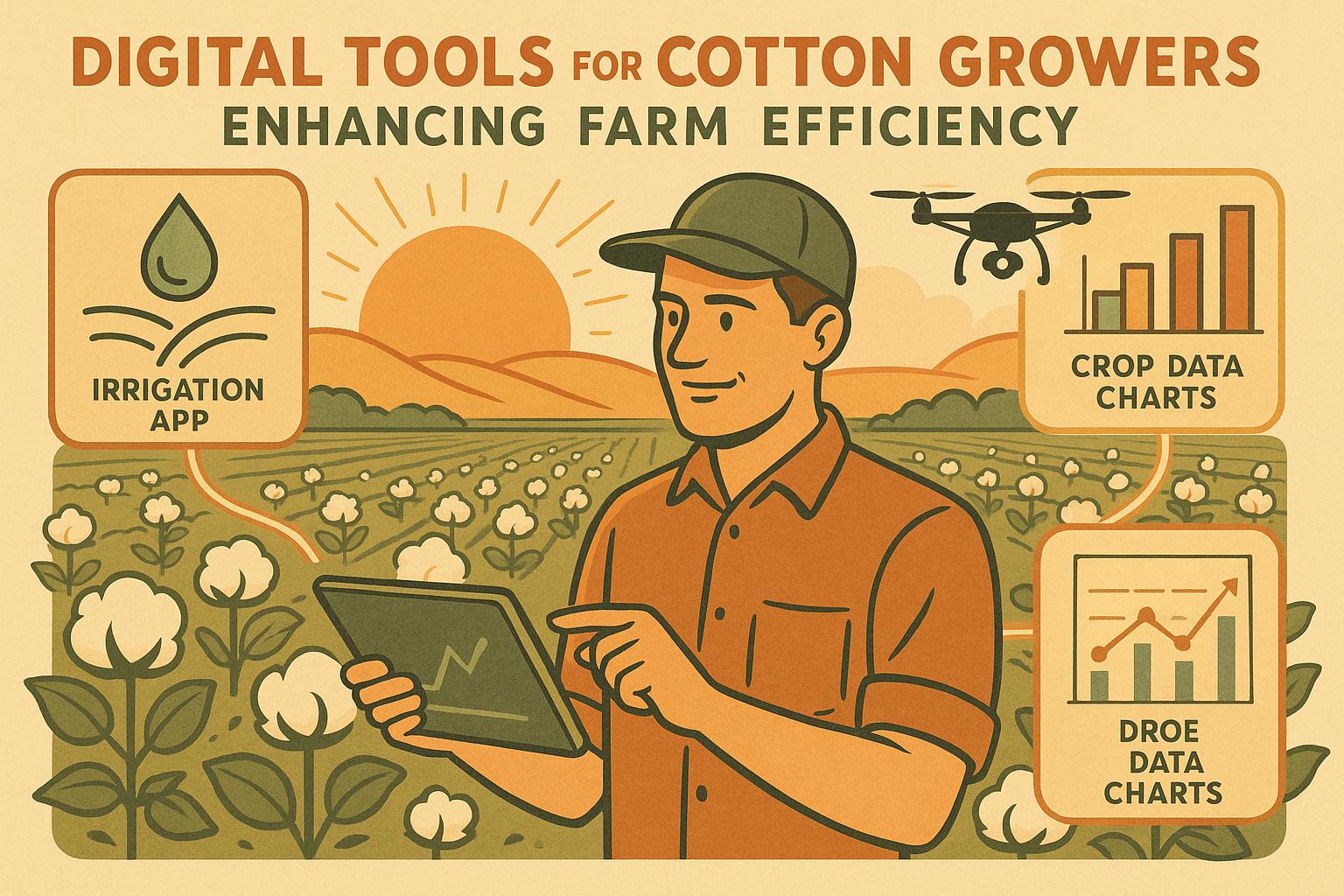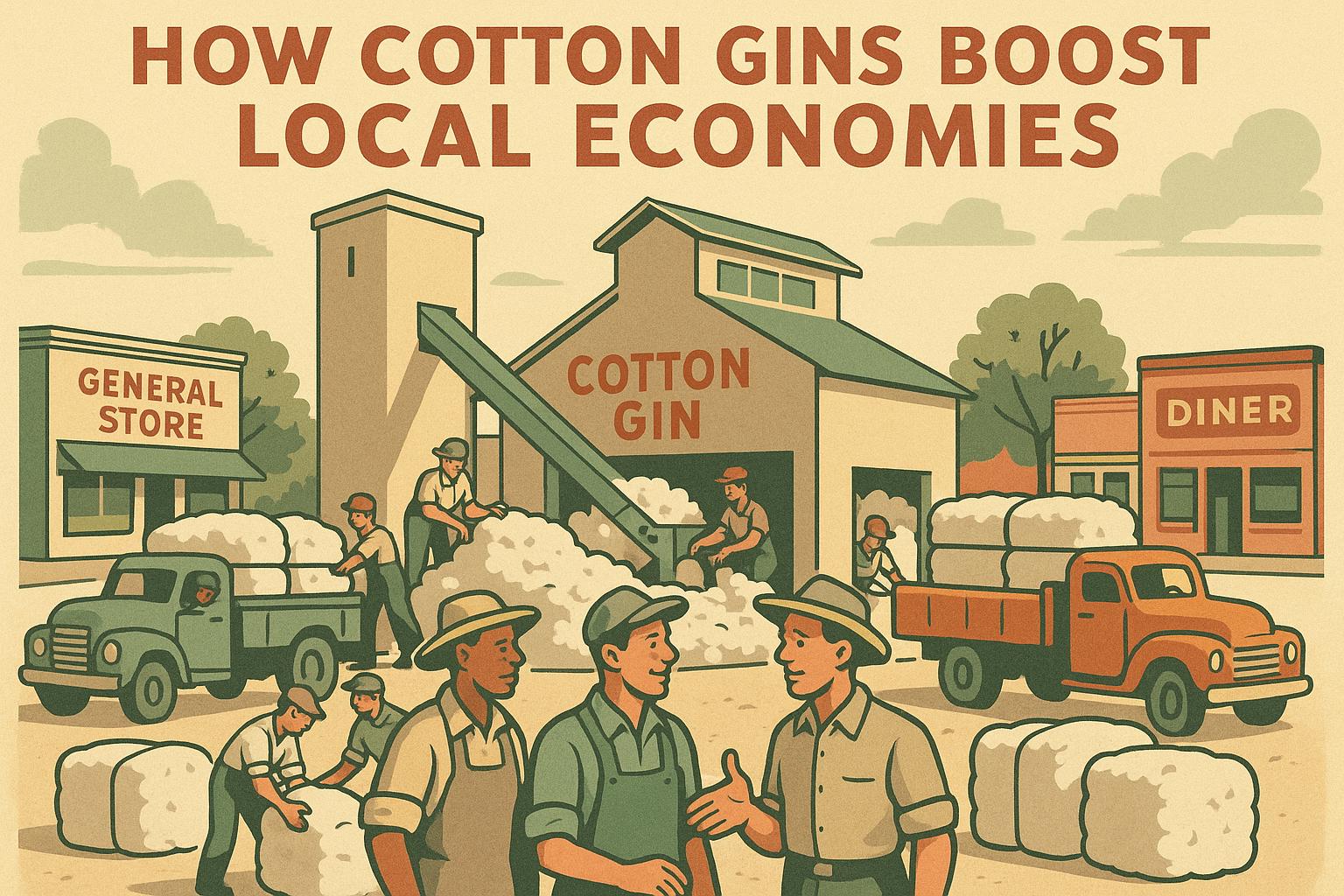Cotton gins are vital in transforming raw cotton into market-ready products, impacting the U.S. cotton industry’s global competitiveness. The cotton gin market was valued at $1.2 billion in 2024, with a projected 5.1% annual growth rate from 2026 to 2033. Profitability hinges on efficient operations, cost management, and adapting to market fluctuations. Key highlights include:
- Revenue Sources: Cotton gins generate income from both cotton lint and cottonseed.
- Cost Breakdown: Labor accounts for 37.64% of variable costs, with total variable costs averaging $17.91 per bale.
- Market Trends: Cotton prices and global demand directly affect ginning volumes and profitability.
- Efficiency Gains: Investments in energy-efficient equipment and automation lower costs and improve output.
- Revenue Diversification: Services like cottonseed processing, premium ginning, and storage rentals boost income.
The cost of cotton production | Georgia Stories
Cotton Market Prices and Their Effects
Cotton market prices ripple through the entire ginning industry, shaping processing volumes, revenue potential, and operational strategies. By understanding these market dynamics, gin operators can make smarter decisions about capacity, equipment investments, and long-term business planning. This interplay between price and strategy is key to grasping broader market trends.
Global Cotton Market Trends
The global cotton market is in constant motion, driven by shifting supply and demand. Recent figures reveal slight increases in production, consumption, and trade worldwide. However, with ending stocks hitting a low in 2021, cotton prices have experienced upward pressure.
International demand plays a pivotal role in domestic ginning operations. For example, the USDA forecasts global mill usage of cotton to grow by 5.0 million bales (4.5%) to reach 115.9 million bales in 2023–24. This robust demand might encourage U.S. growers to plant more cotton, offering gin operators increased processing volumes. Yet, volatility remains a hurdle. A USDA report from August 2023 projected a 5% drop in global cotton yield - down to 770 kilos per hectare from the previous year - highlighting the effects of economic uncertainty and price pressures.
The U.S. cotton market, heavily reliant on exports, faces growing competition globally. International trade policies, tariffs, and broader economic conditions play crucial roles in shaping prices.
How Cotton Price Changes Affect Gin Revenue
Fluctuations in cotton prices directly influence gin profitability and operational strategies. Price volatility can make profitability unpredictable, pushing operators to focus on efficiency to manage risk. When prices rise, growers often expand planted acreage, leading to higher processing volumes for gins.
Take Arkansas as an example. In 2024, cotton acreage in the state grew by 27% - an increase of 140,000 acres - reaching 650,000 acres, the highest level since 2011. This expansion resulted in a busy year for the state’s 26 gins, which processed nearly 2 million bales of cotton. On the flip side, falling prices often prompt growers to switch to alternative crops like soybeans, which are less expensive to produce and require less management. Such shifts reduce demand for ginning services, forcing operators to rethink capacity and staffing plans.
| Market Condition | Grower Response | Gin Impact |
|---|---|---|
| High Cotton Prices | Increased acreage planting | Higher processing volumes; longer seasons |
| Low Cotton Prices | Shift to alternative crops | Reduced volumes; potential consolidation |
| Price Volatility | Cautious planting decisions | Unpredictable capacity utilization |
Seasonal price changes also shape revenue patterns. Cotton prices tend to fluctuate with the harvest season, global supply releases, and shifting demand. In the U.S., the cotton harvest primarily takes place in the fall, with most ginning activity occurring between September and December. Price movements during this critical window can significantly influence annual revenues.
To navigate these risks, gin operators are focusing on operational efficiency. Strategies like reducing energy use, minimizing downtime, and optimizing labor help maintain profitability even when prices drop. Monitoring price trends also enables smarter investments in equipment and better capacity planning.
Interestingly, the global market for cotton ginning machinery is expected to grow from $3.17 billion in 2024 to $3.4 billion in 2025. This growth reflects the industry’s confidence, even in the face of market uncertainty. By adopting advanced technology, gin operators are cutting per-bale costs and improving efficiency, positioning themselves to weather downturns and seize opportunities during favorable price periods.
Managing Costs and Improving Operations
Keeping costs in check is what separates successful cotton gins from those struggling to stay afloat. With labor making up 37.64% of variable expenses and total variable costs averaging $17.91 per bale, finding ways to cut costs without sacrificing efficiency is critical. The key lies in identifying cost drivers and targeting them for meaningful improvements.
Main Cost Factors in Cotton Gin Operations
Labor is the biggest expense, taking up more than a third of variable costs. This makes streamlining workforce operations - whether through automation, better scheduling, or training - a top priority. Energy costs, which account for 7.1% of variable expenses, also present opportunities for savings through energy-efficient equipment and monitoring systems.
Another major cost driver is equipment maintenance and capital investment. Regular maintenance is essential to keep modern ginning equipment running smoothly and to avoid costly breakdowns. However, the initial cost of purchasing high-quality machinery can be a financial strain. Balancing these expenses is critical to maintaining efficiency.
The size of the operation also plays a role. Across the country, fewer gins are processing larger volumes, which helps spread fixed costs over more bales and improves overall efficiency.
| Cost Category | Impact on Operations | Management Strategy |
|---|---|---|
| Labor (37.64% of variable costs) | Largest variable expense | Automation, efficient scheduling, training |
| Energy (7.1% of variable costs) | Significant utility expense | Energy-efficient equipment, monitoring |
| Equipment Maintenance | Affects efficiency and uptime | Preventive maintenance, use of quality parts |
Technology Upgrades for Lower Costs
Once the main cost drivers are under control, upgrading technology can lead to further savings. Modern ginning systems are designed to cut costs while boosting efficiency. For example, automated systems can significantly reduce labor needs, which is especially valuable in areas with high wages. Similarly, energy-efficient machines can bring down utility bills, and predictive maintenance tools can help catch problems early, avoiding expensive repairs.
The cotton ginning machinery market is expected to grow at a 7.4% annual rate, fueled by innovations like remote monitoring and automated controls. These advancements not only reduce labor and energy expenses but also help prevent costly equipment failures.
Large-scale gins that incorporate mechanized technology can process more bales at faster speeds, lowering the cost per bale. However, before investing in new technology, operators should perform a detailed cost-benefit analysis to estimate long-term savings in labor, energy, and maintenance. Exploring options like government grants, tax incentives, or leasing programs can also make these upgrades more affordable.
Focusing on upgrades that deliver the most impact - such as automation to cut labor costs, energy-efficient systems to reduce utility bills, and predictive maintenance tools to extend equipment life - can lead to sustainable savings. These steps not only improve cost management but also set the stage for future revenue growth, which will be discussed later.
sbb-itb-0e617ca
Ways to Increase Cotton Gin Revenue
Expanding on cost management strategies, finding ways to diversify revenue and implement smart pricing can significantly boost profitability. With the cotton gin market expected to reach $1.2 billion in 2024 and grow to $1.88 billion by 2033, operators who adapt to changing demands can tap into new income streams. The secret lies in strategic pricing and offering services beyond traditional ginning operations.
Setting the Right Ginning Fees
Pricing is a critical factor that directly influences both competitiveness and profitability. Successful cotton gin operations strike a balance between market rates and operational efficiency. Using data-driven pricing - factoring in regional trends and seasonal demand - can help optimize fee structures while spreading fixed costs more effectively. Beyond setting fees, introducing additional services can further enhance revenue potential.
Adding New Revenue Sources
Diversifying income streams reduces dependence on processing volume and opens new opportunities. For example, cottonseed processing can transform byproducts into oil, meal, or hulls, creating additional revenue. Similarly, traceability solutions, such as DNA tagging systems for premium or organic cotton, allow operators to participate in high-value supply chains. This not only meets the growing demand for verified sustainable cotton but also justifies premium pricing.
Unused warehouse space can generate income during the off-season through storage rentals or logistics services. Adding fiber quality testing equipment is another way to increase revenue, as detailed reports can support higher processing fees. Long-term partnerships with textile manufacturers can also secure steady business, especially when offering custom ginning for specialized cotton varieties at premium rates. Additionally, experienced operators can explore consulting opportunities, such as advising on sustainability practices or assisting with organic certification. These services often come with high margins and require minimal overhead.
Investing in technology is another way to support revenue diversification. Modern, multi-purpose ginning equipment and predictive maintenance systems ensure reliable service, which is crucial for securing premium contracts. With the cotton ginning machinery market projected to grow from $160.5 million in 2025 to $195.4 million by 2032, technology is becoming increasingly essential for staying competitive and expanding service offerings. By combining strategic pricing with a variety of services, cotton gin operators can build a more resilient and profitable business model.
Using cottongins.org for Business Growth

When it comes to growing your cotton gin business, digital platforms are a game-changer. They not only help you reach a wider audience but also open up new revenue opportunities. Smaller gins can level the playing field with larger operations, while established facilities can uncover fresh ways to expand their reach and boost profitability.
Connecting with the Industry Through cottongins.org
cottongins.org serves as a central hub for U.S. cotton gins, covering major cotton-producing states like Texas, Georgia, Mississippi, Arkansas, and California. This directory simplifies the process for cotton producers, buyers, and service providers to find local gins or explore new markets.
Adding your gin to the directory is straightforward with the "Submit A Gin" feature. By entering key business details, you ensure your facility is visible to potential clients searching for cotton gins in your area. Keeping your listing complete and up-to-date is crucial for maximizing visibility.
The platform goes beyond being just a directory - it’s a tool for fostering valuable connections. Cotton gin operators can discover potential business partners, suppliers, or service providers, whether locally or in regions they’re looking to expand into. These connections can lead to cost-saving partnerships, knowledge sharing, and improved operational efficiency.
For newer or smaller gins, cottongins.org offers an affordable way to gain exposure. It connects them with buyers and partners who might otherwise focus on larger, more established operations. This expanded reach complements other growth strategies by opening access to broader markets.
Sponsorship Options on cottongins.org
cottongins.org also offers sponsorship packages designed to enhance visibility and attract targeted traffic. These options allow businesses to stand out and reach new clients, especially during peak ginning seasons.
| Sponsorship Type | Monthly Cost | Key Benefits | Best For |
|---|---|---|---|
| Sponsored Post | $200 per post | One-day top placement, social media sharing, and permanent archive | Promoting new services or seasonal campaigns |
| Official Sponsor | $200/month | Footer logo placement, dedicated page, and one free sponsored post annually | Consistent brand visibility |
| Featured Sponsor | $400/month | Premium site placement, footer logo, and two free sponsored posts annually | Maximum exposure and lead generation |
Sponsored Posts are perfect for announcing new services or seasonal updates, offering top-site placement for 24 hours, social media promotion, and long-term SEO benefits.
Official Sponsorships and Featured Sponsorships provide ongoing exposure through dedicated pages and logo placements. With annual discounts, these options are ideal for businesses seeking consistent visibility. Featured Sponsors, in particular, enjoy premium site placement, ensuring maximum attention from visitors.
The platform’s impact is clear. For example, mid-sized gins have reported a 20% increase in service inquiries after upgrading their listings. This demonstrates how cottongins.org can directly contribute to securing new contracts.
Additionally, the site provides analytics and performance tracking, giving operators insights into profile views, click-through rates, and inquiry volumes. This data helps businesses fine-tune their marketing strategies for better results.
Timing matters, too. Many operators ramp up their visibility during peak ginning seasons - typically from August through December - when demand for cotton processing is at its highest. By combining strong digital exposure with efficient operations, cotton gin businesses can position themselves for long-term success.
Key Points for Cotton Gin Profitability
Cotton gin profitability relies on a mix of market awareness, cost management, revenue expansion, and embracing modern technology. Staying informed about cotton price trends and global market shifts is crucial for planning revenue and setting competitive prices. Factors like export demand changes and seasonal variations make consistent monitoring of USDA reports and industry updates a necessity.
Controlling costs plays a big role in boosting profit margins. On average, variable costs in the industry are around $17.91 per bale. By investing in modern ginning equipment and optimizing workflows, operators can significantly improve their efficiency and bottom line.
Expanding revenue streams beyond standard ginning fees is another way to increase profits. The cotton ginning machinery market is expected to hit $3.4 billion by 2025, with a growth rate of 7.3% per year, reflecting growing demand for specialized services. For example, some operators are offering traceability services and premium processing options. In May 2022, Reinhart teamed up with Haelixa and Alliance Ginneries to introduce DNA-based traceability for GOTS-certified cotton using an automated sprayer. These additional revenue channels are further supported by advancements in technology that help cut costs.
Here are a few key profitability metrics to keep in mind:
- Gross Profit per Bale: Ranges from $74 to $122, depending on operational scale and equipment efficiency.
- Variable Cost per Bale: Averaging $17.91, influenced by energy consumption and seasonal factors.
- Net Income per kg: Approximately $0.03, factoring in revenue from cottonseed.
Technology upgrades have a direct impact on profitability by reducing labor costs and speeding up processing. Mechanized ginning increases output while requiring less labor, and predictive maintenance tools further improve operational efficiency.
In addition to operational advancements, building a strong online presence is essential for expanding market reach. Platforms like cottongins.org showcase how a digital network can connect businesses and support growth, particularly in key cotton-producing states such as Texas, Georgia, Mississippi, Arkansas, and California.
Looking ahead, the global agricultural cotton gin market is projected to reach $1.88 billion by 2033, growing at a 5.1% annual rate. By focusing on operational efficiency and strategic market positioning, cotton gin operators can achieve sustainable profitability over the long term.
FAQs
How do changes in global cotton prices affect the profitability of a cotton gin?
Fluctuations in global cotton prices play a big role in shaping the profitability of a cotton gin. When prices climb, farmers are more motivated to grow and sell cotton, which can lead to increased processing fees and higher revenue for gins. On the flip side, when prices drop, the demand for ginning services often declines, squeezing profit margins.
To handle these ups and downs, cotton gin operators need to focus on smart cost management and look for ways to diversify their income sources. Keeping a close eye on market trends and adjusting operations to match pricing changes can also help them stay competitive in an ever-changing market.
How can cotton gin operators reduce labor costs and boost operational efficiency?
To tackle high labor costs and boost efficiency, cotton gin operators have several practical options to consider. One key strategy is using automation to handle repetitive tasks. Modern machinery and technology can take over time-consuming manual processes, cutting down on labor needs while enhancing productivity.
Regular staff training is another important step. Well-trained employees are not only more efficient but also less likely to make costly errors, which helps reduce downtime and keeps operations running smoothly.
Smart scheduling and workforce planning can also make a big difference. By aligning labor needs with peak and off-peak times, operators can cut down on unnecessary overtime and ensure there are enough workers on hand when demand is highest.
Finally, keeping a close eye on operational workflows can uncover areas for improvement. Whether it’s streamlining processes or finding ways to cut waste, these adjustments can lead to significant cost savings and improved profitability over time.
How can cotton gin businesses increase profitability by diversifying their revenue streams beyond traditional ginning fees?
Cotton gin businesses have the potential to increase their profits by branching out into additional revenue streams beyond traditional ginning fees. One way to do this is by offering extra services tailored to farmers' needs, such as cottonseed processing, bale packaging, or even storage solutions. These services not only address customer demands but also open doors to new income opportunities.
Another approach involves selling by-products like cottonseed, which has uses in livestock feed or oil production. Building partnerships with local agricultural companies or manufacturers can help create a reliable market for these materials. On top of that, some cotton gins make use of their resources during the off-season by leasing out equipment or facilities, providing another source of revenue.
By exploring these opportunities and making the most of their existing assets, cotton gin businesses can discover fresh ways to grow and enhance their profitability.


